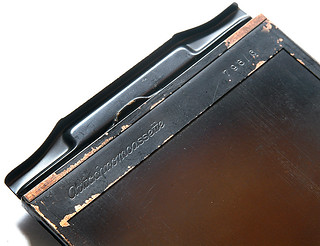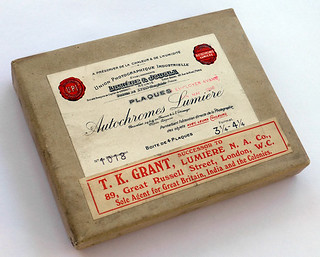Autochrome

|
| Family group outdoors image by George Eastman House (Image rights) |
Autochrome plates are one of the first successful colour photography media, used in the early 20th century. The Lumière brothers' application for a patent was lodged in December 1903.[1] Plates were produced commercially by the Lumière company from 1907 until 1934, by which time Lumière had produced Filmcolor and Lumicolor, first sheet film and later roll film using essentially the same process.[2] Soon after this, however, a number of other successful colour media (especially Technicolor, Agfacolor and Kodachrome) became available, which very largely supplanted the Lumière products. Nevertheless, as late as 1952 Lumière produced Alticolor roll film, still using an additive colour process similar to Autochrome.
The Autochrome process is ingenious, using a single, monochrome silver emulsion to produce a true colour image. It had been known since the mid-19th century that a colour image could be produced by the addition of three component images,[3] on three identical plates each exposed through a different coloured filter (and each also projected through a colour filter). Systems to make colour photographs by this method were sold,[4] but were not easy to use. The Autochrome plate offered a similar process in a single plate. It was not quite the first product to do so; a system was produced in Ireland by John Joly in the late 19th century, but was not commercially very successful.[5]
The relative simplicity of the process, and the fact that photographers needed few facilities beyond those they already had for monochrome plates, made colour photography possible for many amateurs for the first time.
The basis of an Autochrome plate was a three-colour filter layer, or colour screen. This was made from fine grains of starch, mixed from three batches dyed in different colours (orange-red, green and violet-blue). The glass plate was coated with a mixture of gelatine and glycerine, and the coloured starch grains were dusted onto this. Excess starch grains were removed by blowing, leaving a layer one grain thick stuck to the glass. The plate was then passed between rollers under pressure of 2500 lb/in2 to press the starch grains to a flatter shape, leaving them more translucent and also making them expand sideways to fill most of the gaps between them. The flattened grains thus formed a random array of colour filters (the earlier Joly plates had the colour filters as a regular pattern of thin printed stripes,[5] and competing processes also had regular-patterned colour screens). Fine black powder, described as powdered charcoal in some sources, and lamp-black (i.e. soot) in others, was dusted onto the plate, to adhere to the glycerine in any remaining gaps, and prevent the passage of unfiltered light. Excess charcoal was removed, and the plate dried. A coat of waterproof lacquer was applied over the starch layer. Finally, the gelatine and silver-bromide emulsion was applied over the screen layer. [6][7]
In use, the silver halide emulsion was therefore on the back of the plate; the exposure was made through the starch-grain colour screen and through the glass plate itelf. Because the silver emulsion is more sensitive to the blue end of the spectrum, a special yellow filter was placed over the lens.[8] The presence of the colour screen and yellow filter made the effective speed of the Autochrome plate much slower (between six and seven stops) than contemporary monochrome silver-halide plates, requiring exposures around 100 times longer.[9] A sheet of black paper or velvet was normally placed behind the plate, to protect the emulsion from damage due to contact with the plate holder and prevent reflection of light back onto the plate.[10]

|
| Autochromcassette a Zeiss 9×12cm plate-holder image by Geoff Harrisson (Image rights) |

|
| Autochrome plates 1918 image by Geoff Harrisson (Image rights) |
The plates were developed by a reversal process:[11]
- In the darkroom:
- First development to form a silver negative image
- Bleach stage to remove the silver image in an acid solution of potassium permanganate, without affecting the remaining undeveloped silver halide
- The plates were then transferred to a daylit room (so remaining silver halide was exposed to light)
- Second development (development of the silver positive image made when the plates were exposed to daylight)
- Fix
- Wash
- Dry
- Varnish
Bird photographers Overton & Harper emphasised the ease and speed of the development, saying that a plate could be developed in fifteen minutes, and dried in ten.[9]
The plates can be projected as lantern slides, or viewed against a light background (either simply held against the light, or in a viewer). The starch filter layer made them much denser than normal lantern slides however,[9] perhaps solved with a brighter lamp. When Autochrome plates were introduced, there was no straightforward way of duplicating or printing the images. Colour engraving existed, but would not match the quality of a photograph. Woodhead (1914)[6] states that Autochrome plates could be duplicated; however, whereas in monochrome work, the emulsions would be face to face, this could not be so with colour plates, and the presence of a layer of glass between the original and the duplicate might give reflections that would be problematic. It was necessary to arrange parallel lighting, not a point source. Also, the light used in duplicating must approximate daylight in colour. However, because of its random colour screen, Autochrome did not suffer from Moiré (interference between the two regular grids), one of the problems of duplication with regular-screen processes.
The largest collection of Autochromes is that of the Albert Kahn Museum, including the work of Albert Kahn himself and many photographers working for him. Kahn's original project Archives de la Planète, comprises photographs and later film from many countries of the world. However, the work was interrupted by the First World War, which was also documented by many of Kahn's photographers. Some of the communities photographed for Archives de la Planète were radically changed by the War and subsequent history, so the Archives are a unique document of them.
Notes
- ↑ The Lumières' patent at Autochromes Lumière.
- ↑ Chronology of colour technology and products at Autochromes Lumière.
- ↑ Maxwell J.C. (1861) On the theory of the primary colours (archived); a lecture to the Royal Institution, London. Report in the British Journal of Photography reproduced in Notes on Photographs (archived), a project of George Eastman House.
- ↑ For example, this three-colour separation negative, and colour lantern slide produced from a similar plate, using a system sold by Sanger Shepherd & Co. in England, in the catalogue of the exhibition Cameras: the Technology of Photographic Imaging at the Museum of the History of Science, Oxford, 20 May - 13 September 1997.
- ↑ 5.0 5.1 Joly colour plate in the MHS exhibition.
- ↑ 6.0 6.1 The making of Autochrome plates is described in Woodhead, A.E. (1914) 'Photography in colour'; Journal of the Society of dyers and Colourists Vol. 30, No. 3 (March 1914), pp 78-84.
- ↑ The making of plates is also described in Osterman, Mark (2003), The Autochrome Process at Notes on Photographs (archived), a project of George Eastman House. This has less detail but is more easily accessible.
- ↑ Yellow filters for Autochrome and other early colour media, at Early Photography
- ↑ 9.0 9.1 9.2 Overton, F. and Harper, F. (1913) Bird photography by the direct color process; Auk Vol. 30 (Jan 1913), pp 74-76. In the University of New Mexico's Searchable Ornithological Research Archive.
- ↑ Newman & Guardia Autochrome plate holder, 1928 at Early Photography.
- ↑ Processing is described (in French) in this Autochrome instruction book: La Photographie des Couleurs et les Plaques Autochromes; Société A. Lumière et ses Fils, Lyon, c.1908 (displayed as a Flash object - not downloadable).
Links
- Autochromes Lumière (archived), a former project of the French Ministry of Culture.
- Albert Kahn Museum; this site shows only a few of his Autochromes;
- More are shown at the museum's dedicated Collections site;
- There is also a UK Wordpress site, AlbertKahn.co.uk
- Autochromes in the George Eastman House collection on Flickr
- Autochromes in the Bassetlaw Museum, Retford, UK in the Bassetlaw Museum's Flickr photostream.
- Autochromes of Villa Bonnier in the Swedish National Heritage Board's Flickr photostream.
- Autochromes Contemporains by Frédéric Mocellin (also his Flickr photostream).